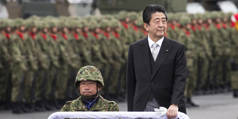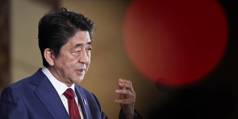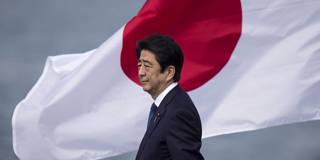US Strategic Ambiguity Over Taiwan Must End
For 40 years, the United States has made a point of not saying whether it would defend Taiwan against a Chinese invasion, an approach that proved effective in deterring rash action by China and by pro-independence Taiwanese. But now that circumstances have changed, so, too, must America's strategy.

How Abe Changed Japan
Former Prime Minister Abe Shinzō’s assassination understandably comes as a shock, given that Japan has not experienced political violence for a half-century. Perhaps not coincidentally, the last top politician to fall victim to a violent attack also had taken steps to strengthen the country’s military posture.
LONDON – Former Japanese Prime Minister Abe Shinzō’s assassination at an election campaign event in Nara, Japan, is both shocking and puzzling. It is shocking because Japan has known almost no political violence for at least a half-century, and because gun ownership in the country is tightly controlled. It is puzzling because Abe, having stepped down as prime minister in 2020, had no formal government role; yet the killing was plainly a political act.
Abe’s death is unlikely to have any impact on the July 10 elections for Japan’s House of Councillors (the upper and therefore junior legislative chamber), which the ruling Liberal Democratic Party was already expected to win comfortably. The tragic loss of the LDP’s former leader and prime minister may add some sympathy votes by increasing turnout, but it has primarily astonished and bewildered a country that is completely unaccustomed to such violence.
Abe’s legacy from his record-setting tenure as prime minister – which was divided between an unsuccessful year in 2006-07, followed by a triumphal return for seven years from 2012 to 2020 – is more notable for its effects on Japanese foreign and security policy than on domestic affairs. To be sure, Abe was a good salesman for his economic-policy agenda, which he successfully promoted under the banner of “Abenomics”; but, in the end, it was his foreign policy, not his economic program, that was transformative.
Abe brought clarity, strength of purpose, and – by dint of his longevity in office – credibility to Japanese foreign policy. The fact that the term “Indo-Pacific” is now commonly used to describe security and diplomatic strategy in Asia is largely owing to Abe, who took a pre-existing Japanese effort to build a stronger relationship with India and used it to reframe and extend his country’s position both regionally and globally.
That stance was dictated by China’s rise and its increasingly assertive rhetoric and actions in and around the South and East China Seas. Under Abe, Japan committed itself to defining a strategic and diplomatic arena that would be harder for China to dominate. Deepening ties with India was part of that strategy, as were Abe’s efforts to strengthen Japan’s military. He was a leading proponent of proposals to amend the country’s constitution so that its military could play a bigger role alongside that of its key ally, the United States.
Abe was undeniably a nationalist. He originally courted controversy with somewhat revisionist views about Japan’s wartime history, especially regarding the hot-button issue of “comfort women” whom the Imperial Japanese Army forced into sexual slavery in occupied countries. Once in office, however, he largely played down his earlier views. Moreover, he built closer and deeper diplomatic relationships across Southeast Asia, improving ties even with the country’s prickliest neighbor and former colony, South Korea. While relations with China were often tense – especially when Abe visited Japan’s controversial Yasukuni Shrine for its war dead – Sino-Japanese dialogue was nevertheless maintained.
It is always difficult to guess the motives of a lone assassin. The man arrested for Abe’s murder, 41-year-old Tetsuya Yamagami, appears to have used a large, homemade shotgun. Given that Japan is one of the world’s safest countries, security at political events tends to be light, even for a former prime minister, which presumably explains how the gunman was able to pull it off.
According to news reports, Yamagami served for three years in Japan’s navy, the Maritime Self-Defense Force, until 2005. That background – combined with Abe’s advocacy of a stronger Japanese military and efforts to eliminate the constitution’s pacifist clause (Article 9) – makes it reasonable to speculate that the killing was committed in protest against the country’s military posture.
Although Abe was no longer in office, he was undoubtedly still the country’s most prominent and well-known advocate of a stronger military capability. In that capacity, he often expressed a determination to complete the work started by his grandfather, Nobosuke Kishi, who, as prime minister in 1960, shepherded through a revision to the country’s security treaty with the US, with a view to reinforcing Japanese defense.
Sadly, it is perhaps not coincidental that the last Japanese prime minister to fall victim to a violent attack was Kishi, who was stabbed by an assailant six times shortly after the revised security treaty was approved. Unlike Abe, however, his grandfather survived.

Shinzo Abe’s Asia-Pacific
Former Japanese Prime Minister Shinzo Abe knew that engagement with China was vital to ease tensions and mitigate risks. But he also knew that to ensure peace and prosperity in the region, engagement had to be complemented by solid economic and security alliances with other major powers, especially the US and India.
CLAREMONT, CALIFORNIA – It has been over a year since Shinzo Abe, Japan’s longest-serving prime minister, resigned due to illness. His successor, Yoshihide Suga, has come and gone. But institutional innovations that Abe spearheaded – namely, the Comprehensive and Progressive Agreement for Trans-Pacific Partnership (CPTPP) and the Quadrilateral Security Dialogue, or Quad – look likely to shape Asia’s geopolitical landscape for a long time to come.
Abe worked tirelessly to deliver the CPTPP, after Donald Trump effectively torpedoed its predecessor pact, the Trans-Pacific Partnership, by withdrawing the United States. The agreement that Abe revived currently includes 11 Asia-Pacific countries, with combined economic output of nearly $14 trillion.
Moreover, the CPTPP’s ranks are set to grow. The United Kingdom formally applied to join the pact last February. In September, China did the same, in an apparent effort to highlight its commitment to free trade – and set itself further apart from the US. Taiwan applied six days later.
If the UK joins the CPTPP, as now seems likely, it will add $2.7 trillion – or about 20% – to the bloc’s total economic output. Dealing with the Chinese and Taiwanese applications will be trickier. Taiwan is technically better qualified to join than China is, but the decision to admit Taiwan and reject China could stoke tensions and even spur conflict – a prospect that CPTPP signatories would prefer to avoid.
But, from a strategic perspective, it is with regard to the US that the CPTPP will make the biggest difference. While Trump is out of the White House, the US has not shaken Trump’s protectionism, and President Joe Biden has not mustered the political courage to join the pact. Yet the CPTPP is integral to the success of US efforts to counter China’s economic influence in Asia. Eventually, Biden should acknowledge this. When he does, he will have Abe to thank for the fact that there is a free-trade agreement in place that the US can join.
Abe’s legacy has been even more consequential and far-sighted in the security arena. He proposed the Quad as a regional security forum – comprising Australia, India, Japan, and the US – back in 2007, during his brief first stint as Japan’s prime minister. Although the Quad was largely inactive for the next decade, the parties agreed to reinvigorate it in 2017, owing largely to Abe’s prodding and China’s growing assertiveness.
The Biden administration now regards the Quad as a critical component of its strategy to keep China in check. In September, the group’s leaders met for an in-person summit at the White House – a gathering future historians will likely point to as a pivotal moment in the Sino-American strategic rivalry.
But the Quad is about far more than diplomatic symbolism. It is also strengthening its joint military capabilities. Last year, it held its first joint naval exercise, Malabar 2020, off the southeast coast of India. It followed up in August with Malabar 2021, held off the coast of Guam.
Given his leadership in forging the CPTPP and the Quad, one might assume that Abe was an unapologetic China hawk, bent on containment. But that assessment overlooks the third pillar of Abe’s geopolitical strategy: direct engagement with China.
In fact, even as he actively promoted the CPTPP and the Quad, Abe took care to ensure that Japan’s relations with China remained stable and cooperative. He visited Beijing in October 2018, and invited Chinese President Xi Jinping to visit Japan in April 2020, though that plan was derailed by the COVID-19 pandemic.
Ultimately, Abe was a supreme realist when it came to China. He knew that bilateral engagement was vital to ease tensions and mitigate risks. But to ensure peace and prosperity in Japan, such engagement had to be complemented by solid economic and security alliances with other major powers, especially the US and India. Only then would China take Japan seriously, treating it as an equal partner in East Asia.
Today, the third pillar of Abe’s China strategy appears to have collapsed. The Biden administration convinced Suga to ramp up Japan’s security commitments in ways that China’s rulers view as hostile. The Sino-Japanese relationship soon reached a new low.
Fortunately, Suga’s successor, Prime Minister Fumio Kishida, might have more room to maneuver. Thanks to Abe’s strategic foresight, Japan is now in a stronger geopolitical position than China. Indeed, China needs Japan more than Japan needs China, because China must maintain a workable relationship with Japan if it wants to frustrate America’s strategy of economic decoupling and security containment. So, if tensions begin to subside, China may well be the one to reach out to Japan in an effort to restore relations. Such an initiative would leave all of Asia better off.

Abe Shinzō’s Unmatched Legacy
As the longest-serving prime minister in the history of Japanese democracy, Abe Shinzō fundamentally transformed the country’s security doctrine and economic-policy trajectory. The foundation of reforms and alliances that he established will remain in place for many years to come.
TOKYO – The assassination of former Japanese Prime Minister Abe Shinzō is as sad as it is shocking. Gun violence is exceedingly rare in Japan, and it seems clear already that both the Nara local police and the Security Police (secret service) were ill-prepared to protect him.
For Japanese of my generation, the tragedy calls to mind US President John F. Kennedy’s assassination in 1963 and the attempted assassination of Abe’s grandfather, Japanese Prime Minister Nobusuke Kishi, who was stabbed in 1960 after his government overcame parliamentary resistance to secure passage of the US-Japan Security Treaty. Under that agreement, the United States committed to providing a security umbrella over Japanese territory in exchange for Japan hosting US land, air, and sea bases. It was a treaty between unequal friends, and one of Abe’s major accomplishments was to develop a more balanced bilateral relationship.
Abe served as prime minister twice, first from September 2006 to September 2007, and then from December 2012 to September 2020, making him the longest-serving prime minister in Japan’s history of democratic governments since 1885. While his first stint leading a government was not particularly successful, his second premiership was politically and economically transformative.
With its revision to Japan’s position on the principle of “collective self-defense,” Abe’s second government cemented ties with the US by making it possible for Japanese forces to protect US forces in the country’s vicinity. Then, by fostering a close golf-buddy relationship with then-US President Donald Trump, Abe managed to preserve a strong US-Japan alliance through the years of “America First” policies. And with his advocacy of a “Free and Open Indo-Pacific,” Abe played a key role in creating the Quad (Australia, India, Japan, and the US) and laying the foundation for a structure of peace across the region.
Domestically, Abe launched an economic program, dubbed “Abenomics,” that included three “arrows.” The first arrow was an aggressive monetary policy designed to overcome the Japanese economy’s long bout of deflation. In early 2013, Abe introduced a new inflation-targeting regime and appointed Haruhiko Kuroda as governor of the Bank of Japan. Kuroda was given wide latitude to push inflation toward its target rate through ultra-loose monetary policies.
The second arrow of Abenomics was a flexible fiscal policy, whereby the government would stimulate the economy during downturns and tighten its policies during booms. Abe implemented a large initial stimulus upon becoming prime minister in December 2012, and then followed this up with two increases to the consumption tax rate. When the COVID-19 threat emerged during his final months in office, his government responded with another round of stimulus (and deficit financing). Ultimately, the second arrow thus translated into a sensible countercyclical Keynesian policy, rather than as a justification, à la Modern Monetary Theory, for piling stimulus upon stimulus.
The third arrow of Abenomics, structural economic reform as growth strategy, was more controversial, with many observers regarding it as unfinished business, if not a failure. To be sure, the Japanese economy’s average growth rate during Abe’s second stint in office was similar to that of the previous ten years. Under Abe, however, the economy’s growth was more stable, with the country avoiding the kind of stagnation that had preceded his premiership, despite the ongoing decline of the country’s working-age population.
I had the privilege of working with Abe when he appointed me to the Prime Minister’s Council on Economic and Fiscal Policy in 2006. During his first premiership, Abe’s primary focus was on political reforms to make Japan stronger and “beautiful,” a key word in his 2007 manifesto-style book. He did not yet have a strong view on economic policy, so he asked the Council to devise an array of policy recommendations that would enable the economy to recover its growth potential.
To that end, we recommended expanding the country’s free-trade agreements; transforming Haneda Airport (which is closer to downtown Tokyo than Narita International Airport) to host international flights; increasing the number of foreign workers in Japan; implementing labor-market reforms to involve more women and the elderly; reforming public pensions; and consolidating stock and commodity exchanges. But Abe resigned after only one year, so our recommendations were not acted upon.
When Abe returned to power in 2012, he seemed to be much more economically literate and assertive. In pursuing the third arrow of Abenomics, he managed to increase the labor force participation rate for women (“womenomics”) and the elderly, and relaxed visa requirements to attract more foreign workers and tourists. He also played a central role in negotiating the Trans-Pacific Partnership and its successor, the Comprehensive and Progressive Agreement for Trans-Pacific Partnership, and he pushed through reforms to the Government Investment Pension Fund, reducing its holdings of low-interest Japanese government bonds relative to domestic and foreign equities and foreign bonds.
In other words, Abe used his second stint in office to pick up where our Council had left off in 2007. I feel honored to have played a part in these reforms, and I doubtless speak for many when I say that Abe’s tragic, heart-wrenching death is a great loss for Japan and the world. His drive for national security and economic reform will be remembered and built upon for years to come. May his soul rest in peace.

TOKYO – Russia’s invasion of Ukraine has reminded many people of the fraught relationship between China and Taiwan. But while there are three similarities between the situation in Ukraine and Taiwan, there are also significant differences.
The first similarity is that there is a very large military power gap between Taiwan and China, just as there was between Ukraine and Russia. Moreover, that gap is growing larger every year.
Second, neither Ukraine nor Taiwan has formal military allies. Both countries are forced to confront threats or attacks alone.
Third, because both Russia and China are permanent, veto-wielding members of the United Nations Security Council, the UN’s mediation function cannot be relied upon for conflicts in which they are involved. This has been the case with the current Russian attack on Ukraine, and it would also be the case in any crisis over Taiwan.
But the situation surrounding Taiwan is even more uneasy. While Taiwan has no allies, it does have the Taiwan Relations Act, a 1979 US law requiring the United States to provide Taiwan with the military equipment and supplies “necessary to enable Taiwan to maintain a sufficient self-defense capacity.” This law has functioned as a form of compensation for America’s unwillingness to say explicitly that it will “defend Taiwan” should it be attacked. This arrangement should now change.
In response to Russia’s aggression against Ukraine, the US stated early on that it would not deploy its troops in Ukraine’s defense. But when it comes to Taiwan, the US has adopted a policy of strategic ambiguity. This is the second point of difference: it remains unclear whether the US would intervene by force in a crisis involving Taiwan.
Because the US prefers to leave undefined its position on how it would respond to an assault on Taiwan, China has (at least up to now) been discouraged from military adventurism. This is so because China’s rulers must account for the possibility that the US would indeed intervene militarily. At the same time, US ambiguity has forced Taiwan to consider the possibility that the US will not intervene militarily, and this has deterred radical pro-independence groups on the island.
The US has maintained its Janus-faced policy for decades. But the third, most important difference between Ukraine and Taiwan suggests strongly that it is time for the US to reconsider its approach. Simply put, whereas Ukraine is an independent state beyond any doubt, Taiwan is not.
Russia’s invasion is not only an armed violation of Ukraine’s territorial sovereignty, but also an attempt to overthrow the government of a sovereign state with missiles and shells. On this point, there is no controversy in the international community over the interpretation of international law and the UN Charter. While the extent to which countries participate in sanctions against Russia has differed, no country has claimed that Russia is not in serious violation of international law.
By contrast, China claims that Taiwan is “part of its own country,” and the US and Japanese position is to respect this claim. Neither Japan nor the US has official diplomatic relations with Taiwan, and most countries around the world do not recognize Taiwan as a sovereign state. Unlike in Ukraine, Chinese leaders could claim that any invasion of Taiwan that China launches is necessary to suppress anti-government activities in one of its own regions, and that such acts therefore would not violate international law.
When Russia annexed Crimea, the international community ultimately acquiesced, even though Russia had violated Ukrainian sovereignty. Given this precedent, it is not surprising that Chinese leaders may very well expect the world to be more tolerant should they, too, adopt the logic of “regional” – rather than national – subjugation.
This logic has made strategic ambiguity untenable. The policy of ambiguity worked extremely well as long as the US was strong enough to maintain it, and as long as China was far inferior to the US in military power. But those days are over. The US policy of ambiguity toward Taiwan is now fostering instability in the Indo-Pacific region, by encouraging China to underestimate US resolve, while making the government in Taipei unnecessarily anxious.
Given the change in circumstances since the policy of strategic ambiguity was adopted, the US should issue a statement that is not open to misinterpretation or multiple interpretations. The time has come for the US to make clear that it will defend Taiwan against any attempted Chinese invasion.
Whenever I met President Xi Jinping during my time as prime minister, I always made it a rule to convey clearly to him that he should not misjudge Japan’s intention to defend the Senkaku Islands, and that Japan’s intentions were unwavering. The human tragedy that has befallen Ukraine has taught us a bitter lesson. There must no longer be any room for doubt in our resolve concerning Taiwan, and in our determination to defend freedom, democracy, human rights, and the rule of law.